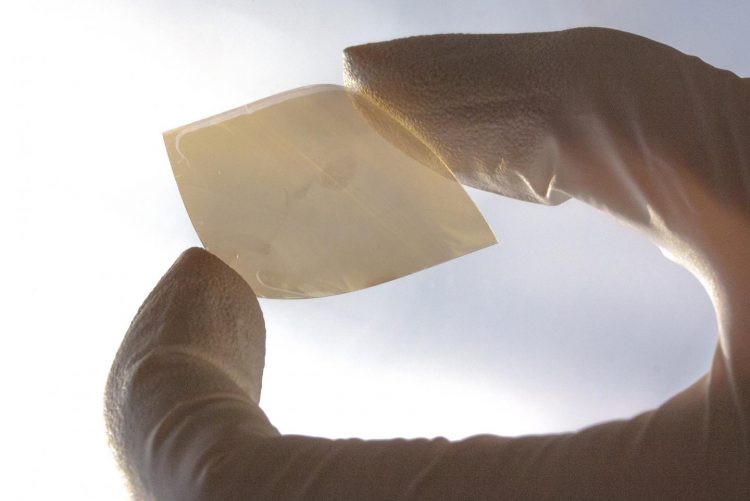New method can make cheaper solar energy storage

This is a photograph of a single-flake-layer WSe2 thin film deposited on flexible Sn:In2O3 (ITO)-coated PET plastic. Credit: Kevin Sivula (EPFL)
However, the cost of producing efficient solar panels makes water-splitting technologies too expensive to commercialize. EPFL scientists have now developed a simple, unconventional method to fabricate high-quality, efficient solar panels for direct solar hydrogen production with low cost. The work is published in Nature Communications.
Many different materials have been considered for use in direct solar-to-hydrogen conversion technologies but “2-D materials” have recently been identified as promising candidates. In general these materials–which famously include graphene–have extraordinary electronic properties.
However, harvesting usable amounts of solar energy requires large areas of solar panels, and it is notoriously difficult and expensive to fabricate thin films of 2-D materials at such a scale and maintain good performance.
Kevin Sivula and colleagues at EPFL addressed this problem with an innovative and cheap method that uses the boundary between two non-mixing liquids. The researchers focused on one of the best 2-D materials for solar water splitting, called “tungsten diselenide”. Past studies have shown that this material has a great efficiency for converting solar energy directly into hydrogen fuel while also being highly stable.
Before making a thin film of it, the scientists first had to achieve an even dispersion of the material. To do this, they mixed the tungsten diselenide powder with a liquid solvent using sonic vibrations to “exfoliate” it into thin, 2-D flakes, and then added special chemicals to stabilize the mix. Developed by Sivula's lab (2014), this technique produces an even dispersion of the flakes that is similar to an ink or a paint.
The researchers then used an out-of-the-box innovation to produce high-quality thin films: they injected the tungsten diselenide ink at the boundary between two liquids that do not mix. Exploiting this oil-and-water effect, they used the interface of the two liquids as a “rolling pin” that forced the 2-D flakes to form an even and high-quality thin film with minimal clumping and restacking. The liquids were then carefully removed and the thin film was transferred to a flexible plastic support, which is much less expensive than a traditional solar panel.
The thin film produced like this was tested and found to be superior in efficiency to films made with the same material but using other comparable methods. At this proof-of-concept stage, the solar-to-hydrogen conversion efficiency was around 1%–already a vast improvement over thin films prepared by other methods, and with considerable potential for higher efficiencies in the future.
More importantly, this liquid-liquid method can be scaled up on a commercial level. “It is suitable for rapid and large-area roll-to-roll processing,” says Kevin Sivula. “Considering the stability of these materials and the comparative ease of our deposition method, this represents an important advance towards economical solar-to-fuel energy conversion.”
###
This work was funded by the Swiss Competence Centers for Energy Research (SCCER Heat and Electricity Storage) and the European Commission's Framework Project 7 (FP7) through a Marie-Curie Intra-European Fellowship (COCHALPEC).
Reference
Yu X, Prévot MS, Guijarro N, Sivula K. Self-assembled 2D WSe2 thin films for photoelectrochemical hydrogen production. Nature Communications 01 July 2015. DOI: 10.1038/ncomms8596
Media Contact
All latest news from the category: Materials Sciences
Materials management deals with the research, development, manufacturing and processing of raw and industrial materials. Key aspects here are biological and medical issues, which play an increasingly important role in this field.
innovations-report offers in-depth articles related to the development and application of materials and the structure and properties of new materials.
Newest articles

Sea slugs inspire highly stretchable biomedical sensor
USC Viterbi School of Engineering researcher Hangbo Zhao presents findings on highly stretchable and customizable microneedles for application in fields including neuroscience, tissue engineering, and wearable bioelectronics. The revolution in…

Twisting and binding matter waves with photons in a cavity
Precisely measuring the energy states of individual atoms has been a historical challenge for physicists due to atomic recoil. When an atom interacts with a photon, the atom “recoils” in…

Nanotubes, nanoparticles, and antibodies detect tiny amounts of fentanyl
New sensor is six orders of magnitude more sensitive than the next best thing. A research team at Pitt led by Alexander Star, a chemistry professor in the Kenneth P. Dietrich…





















